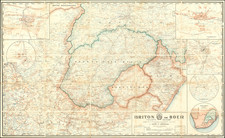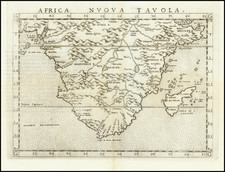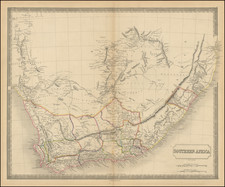Chart from a Storied Surveying Expedition of Africa
Striking sea chart of the southern tip of South Africa, from the surveys of the important Leven and Barracouta expedition of 1822 to 1826.
Besides the Beagle voyages, which included Charles Darwin, the Leven and Barracouta expedition, under the command of William Fitzwilliam Owen, was one of the most famous Admiralty surveying voyages of the 19th century.
The chart shows southern Africa below the 25th parallel. The coast is carefully delineated with coastal terrain, dangers to navigation, and sounding depths, although small stretches of shoreline remain conjectural and largely unexplored.
An inset in the lower right corner focuses on the area just north of Cape Town, including Saldanha Bay.
To the south is a zig-zag line with sounding depths. This is the track of the HMS Heron in 1821, under the command of Captain Jon Hamner, which had been sent in search of the Telemaque Shoals. These treacherous rocks had apparently been sighted in the late-eighteenth century. However, the Heron found no such obstruction, eliminating it from subsequent charts.
The surveying voyage of the Leven and the Barracouta
The voyage on which this chart was drawn is one of the great surveying expeditions of the early 19th century. The Leven and the Barracouta spent 1822-1826 recording the coasts of Africa and the southern Arabian Peninsula. In all, they surveyed 30,000 nautical miles and created an imense number of charts,the sum of which was a monumental contribution to modern navigation in the regions.
The expedition was conducted was under the command of Captain William Fitzwilliam Owen. As a young officer, Owen served at the battle of the Glorious First of June (1794) and later commanded a fireship that was part of Nelson’s attempt to ignite the French navy at Boulogne. In 1803, in command of the Seaflower, Owen began hydrographic work while in the Maldives.
His next few posts were all in the Indian Ocean until, in 1815, he was sent to Ontario to survey the Great Lakes. His good work there recommended him for another surveying expedition, this time along the east coast of Africa. The Admiralty appointed him to the Leven, with the Barracouta also under his command, a ship in which he had previously served. The initial officer in charge on the Barracouta died in 1823; it was taken over by Owen’s first lieutenant, Alexander Vidal, who had served under Owen in the Great Lakes.
Over the course of four surveying seasons, the ships ranged the east coast of Africa, the southern Arabian Peninsula, Madagascar, and several Indian Ocean islands. The crews became very ill and half of each ship’s complement died. Owen also patrolled for slavers and set up an unsanctioned protectorate in Mombasa, where the Masrai rulers agreed to abolish slavery if Owen helped them to lift a siege by the Sultan of Oman. From 1825, the ships began a slow return to England, covering the west coasts of Africa as they went.
In addition to the many Admiralty charts that resulted from the voyage, Owen wrote A Narrative of a Voyage to Explore the Shores of Arica, Arabia, and Madagascar (1833). A lieutenant serving on the same expedition, Thomas Boteler, also published an account of those years. He is also included in the list of officers who contributed to this chart.
Rarity
The chart is of the utmost rarity. OCLC locates 2 examples (British Library and Connecticut State Library).
We were unable to locate any examples at auction or in dealer catalogs going back more than 40 years.
The British Admiralty has produced nautical charts since 1795 under the auspices of the United Kingdom Hydrographic Office (HO). Its main task was to provide the Royal Navy with navigational products and service, but since 1821 it has also sold charts to the public.
In 1795, King George III appointed Alexander Dalrymple, a pedantic geographer, to consolidate, catalogue, and improve the Royal Navy’s charts. He produced the first chart as the Hydrographer to the Admiralty in 1802. Dalrymple, known for his sticky personality, served until his death in 1808, when he was succeeded by Captain Thomas Hurd. The HO has been run by naval officers ever since.
Hurd professionalized the office and increased its efficiency. He was succeeded by the Arctic explorer Captain William Parry in 1823. By 1825, the HO was offering over seven hundred charts and views for sale. Under Parry, the HO also began to participate in exploratory expeditions. The first was a joint French-Spanish-British trip to the South Atlantic, a voyage organized in part by the Royal Society of London.
In 1829, Rear-Admiral Sir Francis Beaufort was appointed Hydrographer Royal. Under his management, the HO introduced the wind force scale named for him, as well as began issuing official tide tables (1833). It was under Beaufort that HMS Beagle completed several surveying missions, including its most famous voyage commanded by Captain FitzRoy with Charles Darwin onboard. When Beaufort retired in 1855, the HO had nearly two thousand charts in its catalog.
Later in the nineteenth century, the HO supported the Challenger expedition, which is credited with helping to found the discipline of oceanography. The HO participated in the International Meridian Conference which decided on the Greenwich Meridian as the Prime Meridian. Regulation and standardization of oceanic and navigational measures continued into the twentieth century, with the HO participating at the first International Hydrographic Organization meeting in 1921.
During World War II, the HO chart making facility moved to Taunton, the first purpose-built building it ever inhabited. In 1953, the first purpose-built survey ship went to sea, the HMS Vidal. Today, there is an entire class of survey vessels that make up the Royal Navy’s Hydrographic Squadron. The HO began to computerize their charts in the late 1960s and early 1970s. In 1968, the compilation staff also came to Taunton, and the HO continues to work from there today.










![[Oranje Freistaat, Transvaal and Kap Kolonie Game Board]](https://storage.googleapis.com/raremaps/img/small/80146.jpg)


![[South Africa]. Charte der Sudspitze Africa und der Colonie vom Vorgebirgedernugen Hoffnung haputeschilich nach Barrow's Neuesten Reisen enworfen und nach astronomischen Ortsbestimungen. . . .1804](https://storage.googleapis.com/raremaps/img/small/47947.jpg)
![(South Africa) Jeppe's Map of the Transvaal or S.A. Republic and Surrounding Territories [Six-Sheet Map]](https://storage.googleapis.com/raremaps/img/small/84245.jpg)